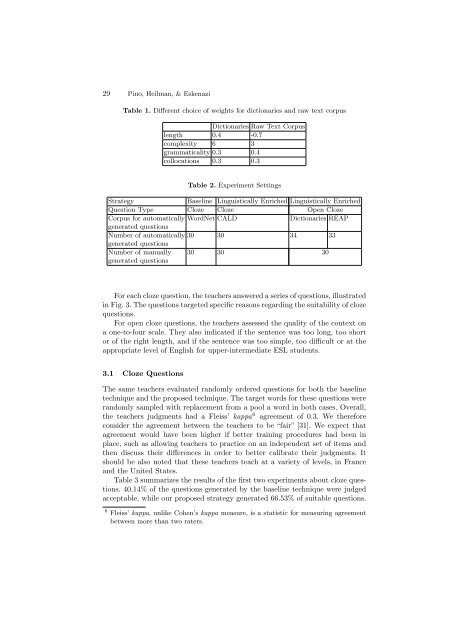Intelligent Tutoring Systems for Ill-Defined Domains - Philippe ...
Intelligent Tutoring Systems for Ill-Defined Domains - Philippe ...
Intelligent Tutoring Systems for Ill-Defined Domains - Philippe ...
Create successful ePaper yourself
Turn your PDF publications into a flip-book with our unique Google optimized e-Paper software.
29 Pino, Heilman, & Eskenazi<br />
Table 1. Different choice of weights <strong>for</strong> dictionaries and raw text corpus<br />
Dictionaries Raw Text Corpus<br />
length 0.4 -0.7<br />
complexity 6 3<br />
grammaticality 0.3 0.4<br />
collocations 0.3 0.3<br />
Table 2. Experiment Settings<br />
Strategy Baseline Linguistically Enriched Linguistically Enriched<br />
Question Type Cloze Cloze Open Cloze<br />
Corpus <strong>for</strong> automatically WordNet CALD Dictionaries REAP<br />
generated questions<br />
Number of automatically 30 30 34 33<br />
generated questions<br />
Number of manually 30 30 30<br />
generated questions<br />
For each cloze question, the teachers answered a series of questions, illustrated<br />
in Fig. 3. The questions targeted specific reasons regarding the suitability of cloze<br />
questions.<br />
For open cloze questions, the teachers assessed the quality of the context on<br />
a one-to-four scale. They also indicated if the sentence was too long, too short<br />
or of the right length, and if the sentence was too simple, too difficult or at the<br />
appropriate level of English <strong>for</strong> upper-intermediate ESL students.<br />
3.1 Cloze Questions<br />
The same teachers evaluated randomly ordered questions <strong>for</strong> both the baseline<br />
technique and the proposed technique. The target words <strong>for</strong> these questions were<br />
randomly sampled with replacement from a pool a word in both cases. Overall,<br />
the teachers judgments had a Fleiss’ kappa 6 agreement of 0.3. We there<strong>for</strong>e<br />
consider the agreement between the teachers to be “fair” [31]. We expect that<br />
agreement would have been higher if better training procedures had been in<br />
place, such as allowing teachers to practice on an independent set of items and<br />
then discuss their differences in order to better calibrate their judgments. It<br />
should be also noted that these teachers teach at a variety of levels, in France<br />
and the United States.<br />
Table 3 summarizes the results of the first two experiments about cloze questions.<br />
40.14% of the questions generated by the baseline technique were judged<br />
acceptable, while our proposed strategy generated 66.53% of suitable questions.<br />
6 Fleiss’ kappa, unlike Cohen’s kappa measure, is a statistic <strong>for</strong> measuring agreement<br />
between more than two raters.


